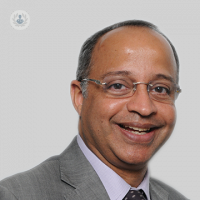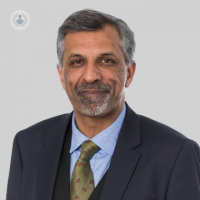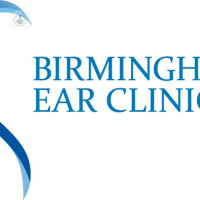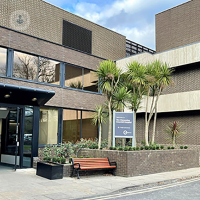What is otosclerosis?
Otosclerosis is a medical condition that affects the bones of the middle ear, specifically the stapes bone. The stapes bone, also known as the stirrup bone, is one of the three tiny bones in the middle ear responsible for transmitting sound vibrations from the outer ear to the inner ear.
In otosclerosis, abnormal bone growth occurs in the middle ear, particularly around the stapes bone. This abnormal bone growth can interfere with the normal movement of the stapes, leading to hearing loss. Otosclerosis is a common cause of conductive hearing loss, which means that it affects the transmission of sound through the ear.
It is very important to have regular check-ups with your otolaryngologist (ENT) specialist to control bone growth and prevent hearing loss.
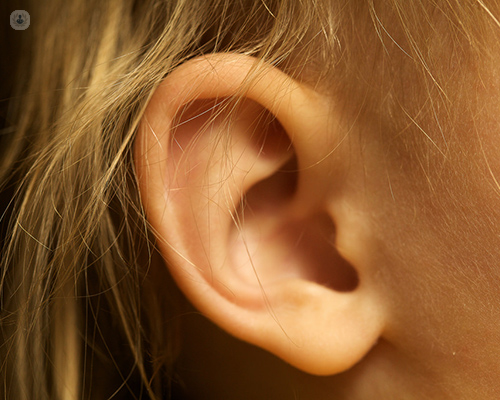
What are the symptoms?
The symptoms of otosclerosis can vary from person to person, and some individuals may experience more severe symptoms than others. Common symptoms of otosclerosis include:
Gradual hearing loss: This is the most common and characteristic symptom of otosclerosis. Hearing loss in otosclerosis typically starts in one ear but can eventually affect both ears. The hearing loss is often progressive and may become more significant over time.
Tinnitus: Many individuals with otosclerosis experience tinnitus, which is a ringing, buzzing, or hissing noise in the affected ear(s). Tinnitus can be constant or intermittent and is often more noticeable in quiet environments.
Dizziness or balance issues: While less common, some individuals with otosclerosis may experience dizziness or problems with balance. This is typically due to the involvement of the inner ear structures or pressure changes caused by the condition.
Sound distortion: Some people with otosclerosis may perceive sounds as distorted or muffled. This can make it challenging to understand speech or hear certain frequencies clearly.
Difficulty hearing in noisy environments: Individuals with otosclerosis may have particular difficulty hearing and understanding speech in noisy environments, such as crowded restaurants or social gatherings.
What are the causes of otosclerosis?
The symptoms of otosclerosis are produced by the abnormal growth of a spongy bone in the middle ear. This prevents the bones of the middle ear from vibrating to the sound waves and therefore makes hearing impossible.
The cause of otosclerosis itself is unknown, although there is a hereditary factor involved.
Is otosclerosis preventable?
It is not possible to prevent otosclerosis and so its early detection is essential in order to provide the necessary treatment and avoid hearing loss.
Treatment of otosclerosis
Untreated otosclerosis will get worse and affect hearing. To treat the problem a stapedectomy or stapedotomy surgery is performed in which the bones of the middle ear (abutment) are replaced in whole or in part by prosthesis.
09-17-2014 09-27-2023Otosclerosis
Mr Peter Monksfield - Otolaryngology / ENT
Created on: 09-17-2014
Updated on: 09-27-2023
Edited by: Kate Forristal
What is otosclerosis?
Otosclerosis is a medical condition that affects the bones of the middle ear, specifically the stapes bone. The stapes bone, also known as the stirrup bone, is one of the three tiny bones in the middle ear responsible for transmitting sound vibrations from the outer ear to the inner ear.
In otosclerosis, abnormal bone growth occurs in the middle ear, particularly around the stapes bone. This abnormal bone growth can interfere with the normal movement of the stapes, leading to hearing loss. Otosclerosis is a common cause of conductive hearing loss, which means that it affects the transmission of sound through the ear.
It is very important to have regular check-ups with your otolaryngologist (ENT) specialist to control bone growth and prevent hearing loss.

What are the symptoms?
The symptoms of otosclerosis can vary from person to person, and some individuals may experience more severe symptoms than others. Common symptoms of otosclerosis include:
Gradual hearing loss: This is the most common and characteristic symptom of otosclerosis. Hearing loss in otosclerosis typically starts in one ear but can eventually affect both ears. The hearing loss is often progressive and may become more significant over time.
Tinnitus: Many individuals with otosclerosis experience tinnitus, which is a ringing, buzzing, or hissing noise in the affected ear(s). Tinnitus can be constant or intermittent and is often more noticeable in quiet environments.
Dizziness or balance issues: While less common, some individuals with otosclerosis may experience dizziness or problems with balance. This is typically due to the involvement of the inner ear structures or pressure changes caused by the condition.
Sound distortion: Some people with otosclerosis may perceive sounds as distorted or muffled. This can make it challenging to understand speech or hear certain frequencies clearly.
Difficulty hearing in noisy environments: Individuals with otosclerosis may have particular difficulty hearing and understanding speech in noisy environments, such as crowded restaurants or social gatherings.
What are the causes of otosclerosis?
The symptoms of otosclerosis are produced by the abnormal growth of a spongy bone in the middle ear. This prevents the bones of the middle ear from vibrating to the sound waves and therefore makes hearing impossible.
The cause of otosclerosis itself is unknown, although there is a hereditary factor involved.
Is otosclerosis preventable?
It is not possible to prevent otosclerosis and so its early detection is essential in order to provide the necessary treatment and avoid hearing loss.
Treatment of otosclerosis
Untreated otosclerosis will get worse and affect hearing. To treat the problem a stapedectomy or stapedotomy surgery is performed in which the bones of the middle ear (abutment) are replaced in whole or in part by prosthesis.
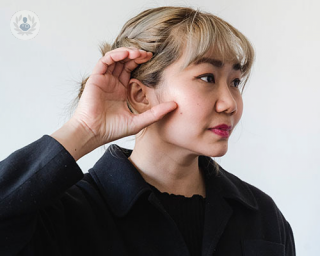

Stapedectomy: what is it and how can it improve my hearing?
By Mr Neil Fergie
2025-01-19
A stapedectomy is a surgical procedure for the treatment of hearing loss caused by a condition called otosclerosis. Leading ENT surgeon Mr Neil Fergie, explains what is a stapedectomy, what are the risks involved, and why stapedectomy patients are among the most satisfied group of ear surgery patients. See more


Otosclerosis: a common cause of hearing loss in young adults
By Mr Abhijeet Parikh
2025-01-14
Leading Consultant Ear, Nose and Throat Surgeon, Mr Abhijeet Parikh, talks about otosclerosis, a middle ear condition that is a common cause of hearing loss in adults. See more


Otosclerosis: what are my treatment options?
By Professor Simon Lloyd
2025-01-14
Otosclerosis is where a small bone in the middle ear becomes stuck in place as a result of bone tissue growing around it, where it shouldn't be. This can, unfortunately, lead to hearing loss and is common in young adults. Our top ENT specialist Professor Simon Lloyd explains how the condition can be treated. See more
Experts in Otosclerosis
-
Mr Abhijeet Parikh
Otolaryngology / ENTExpert in:
- Hearing loss
- Otosclerosis
- Cholesteatoma
- Rhinitis
- Nasal polyps
- Voice disorders
-
Professor Shakeel Saeed
Otolaryngology / ENTExpert in:
- Cochlear Implants
- Endoscopic skull base surgery
- Hearing loss
- Tinnitus
- Cholesteatoma
- Otosclerosis
-
Mr Harry Powell
Otolaryngology / ENTExpert in:
- Cholesteatoma
- Cochlear Implants
- Ear infection
- Tonsillectomy
- Hearing loss
- Otosclerosis
-
Mr Peter Monksfield
Otolaryngology / ENTExpert in:
- Acoustic neuroma
- Hearing loss
- Cholesteatoma
- Tinnitus
- Cochlear Implants
- Otosclerosis
-
Miss Laura Harrison
Otolaryngology / ENTExpert in:
- Tinnitus
- Otology
- Ear infection
- Dizziness
- Glue ear
- Otosclerosis
- See all

Birmingham Ear Clinic
Birmingham Ear Clinic
The Priory Hospital, Priory Road, B5 7UG
No existe teléfono en el centro.
By using the telephone number provided by TOP DOCTORS, you automatically agree to let us use your phone number for statistical and commercial purposes. For further information, read our Privacy Policy
Top Doctors

The Clementine Churchill Hospital - part of Circle Health Group
The Clementine Churchill Hospital - part of Circle Health Group
Sudbury Hill, Harrow HA1 3RX
No existe teléfono en el centro.
By using the telephone number provided by TOP DOCTORS, you automatically agree to let us use your phone number for statistical and commercial purposes. For further information, read our Privacy Policy
Top Doctors

Cleveland Clinic Portland Place Outpatient Centre
Cleveland Clinic Portland Place Outpatient Centre
24 Portland Place, W1B 1LU
No existe teléfono en el centro.
By using the telephone number provided by TOP DOCTORS, you automatically agree to let us use your phone number for statistical and commercial purposes. For further information, read our Privacy Policy
Top Doctors
-
Birmingham Ear Clinic
The Priory Hospital, Priory Road, B5 7UG, EdgbastonExpert in:
- Hearing Implants
- Otology
-
The Clementine Churchill Hospital - part of Circle Health Group
Sudbury Hill, Harrow HA1 3RX, West LondonExpert in:
- Abdominal ultrasound
- Abdominoplasty
- Acne
- Allergies bronchopulmonary
- Allergies nose and ears
- Allergy Dermatitis
-
Cleveland Clinic Portland Place Outpatient Centre
24 Portland Place, W1B 1LU, Central LondonExpert in:
- Diagnosis of Cancer
- Diagnostics
- Women’s health
- Sports Medicine
- General practice
- Health check up
- See all
- Most viewed diseases, medical tests, and treatments
- HHT (Hereditary Haemorrhagic Telangiectasia)
- Snoring
- Polysomnography (sleep study)
- Nystagmus
- Migraine
- Minimal access surgery (keyhole surgery)
- Head and neck cancer
- Neck lump
- Botulinum toxin (Botox™)
- Thyroid disorders

